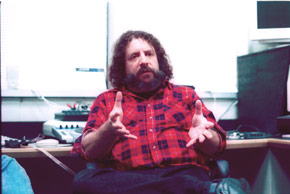November 13, 2001
New electronic
music class appeals to engineers, musicians
Students
study technical aspects of instrument design
by AMANDA MUÑOZ
Daily Editorial Board
 |
|
Electronic Musical Instrument Design students Jesse
PHOTOS BY AMY BERKOWITZ |
Tufts musicians who spend their days as engineering majors got a rare opportunity to combine the disciplines this fall in a class entitled Electronic Musical Instrument Design. The engineering elective class "builds a bridge across the gap between technology and art," according to its professor, Paul Lehrman, a lecturer in the music department.
The class was offered this fall for the first time, and the seven students enrolled have spent the semester learning how to create non-keyboard electronic musical instruments.
"Music, like it or not, has become dependent on technology," Lehrman said. "The people who are in charge of technology need to know more about art, so their technology becomes useful for human beings."
Electronic music made popular by contemporary artists like Moby and Beck has been around for years, according to Lehrman. He says that new techniques and technology and greater accessibility to technology has made the sounds more prominent in today's music scene.
Besides engaging engineers, the class enlightens students' inner musicians. "What's cool about the class is that musicians see... totally different ways to make music outside of the box - any way to make great music," said Todd Nocera, a Tufts graduate student who is Lehrman's teaching assistant.
In the class, students analyze existing electronic instruments such as theremins and woodwind stimulators and learn how to use a Musical Instrument Digital Interface (MIDI) sequencing program and Max, an object-oriented language for processing MIDI data.
The students work in small groups to create three projects throughout the semester, and eventually create their own instruments. A concert during finals week is planned to showcase the prototype instruments.
 Throughout
the class, students must combine their knowledge of mechanical engineering with
their musical abilities. "You need some music ability to be in this class,
[and] you need to be musical to make it work," Lehrman said. "There
is an engineering side - learning about concepts, the hands-on - but it applies
engineering to real life stuff."
Throughout
the class, students must combine their knowledge of mechanical engineering with
their musical abilities. "You need some music ability to be in this class,
[and] you need to be musical to make it work," Lehrman said. "There
is an engineering side - learning about concepts, the hands-on - but it applies
engineering to real life stuff."
The class can count toward the multimedia arts or musical engineering minors. A multimedia arts minor must take classes in both music and engineering, develop his or her own instrument, and conduct research for either Steinway, a piano company, or Selmer, a band instrument company.
Although Electronic Musical Instrument Design is a new offering this semester, a similar class - Musical Instrument Design, in which students engineer their own band instruments - has been around for a few years. Both classes receive funding for equipment from the Steinway and Selmer companies.
Mechanical engineering professor and musical instrument design instructor Chris Rogers said classes that combine engineering and music are both interesting and useful. "I think that's what makes it fun; instruments are associated with black magic and mystique, for example, why a certain brand costs more than another... there is both a scientific point of view and musical point of view," Rogers said.
Lehrman, too, defended the practicality of an instrument engineering course. "What's better, making an obscure wire circuit, or an instrument you can use?" he asked.
Since this is the first semester the electronic design course is offered, the syllabus is something of a work-in-progress - in fact, the students have helped to create it. "The students define how the class is going; the students' skills determine where it's going," Lehrman said. "There is a lot of brainstorming with the students."
 And
some students contribute with specialized knowledge, Lehrman added. "Some
students know more about electronics I do," he said.
And
some students contribute with specialized knowledge, Lehrman added. "Some
students know more about electronics I do," he said.
The students come from different backgrounds in engineering and music, and many play at least one instrument. Sophomore Matt Levine, a computer engineer and trumpet player, saw the class as a great outlet for combining his interests. "I've been interested in music for a long time and I'm an engineer, and it made the next logical step when I saw a flyer for the class to put the two together," Levine said."It's a fun class and I enjoy...being able to play around with all the equipment and try to make music in a new way."
Senior Aidan Collins, an engineering psychology major, says he enjoys the guest speakers, who are involved with electronic music on either the academic or industry level. "We've had guest demonstrators that are really inspiring to watch since I don't know what to do after I graduate," Collins said.
But students also enjoy the experience Lehrman brings to the class. "He's quite a smart guy and knows the equipment," Levine said. "It's nice to have someone who has done stuff in the industry more than he has taught it, someone with first-hand experience."
In addition to teaching at Tufts, Lehrman is a composer, writer, and technologist. He has written scores for television, film, and multimedia, and composed the word's first all MIDI-album in 1986. Lehrman was also the principal author of the standard college text on MIDI, a required book for the course. He has also written numerous articles for major recording and music magazines and is currently the web editor of Mix, an audio and music magazine.
Lehrman taught at the University of Massachusetts Lowell for 12 years before coming to Tufts in 1999. "I'm really happy to be at Tufts - I love the atmosphere and the students," he said.
All material is ©2001 The Tufts Daily. Used with permission.